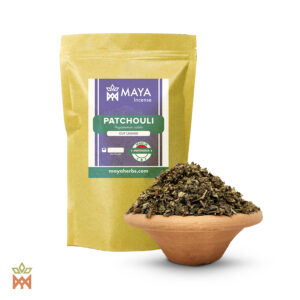Showing all 5 results
- Price range: € 7,50 through € 24,00 Incl. VATSelect options This product has multiple variants. The options may be chosen on the product page
- Price range: € 3,75 through € 50,00 Incl. VATSelect options This product has multiple variants. The options may be chosen on the product page
- Price range: € 9,00 through € 250,00 Incl. VATSelect options This product has multiple variants. The options may be chosen on the product page
Showing all 5 results
Plantkunde van Pogostemon cablin
Pogostemon cablin, beter bekend als patchoeli, is een overblijvende kruidachtige plant die behoort tot de Lamiaceae (munt) familie. De plant komt oorspronkelijk uit tropische gebieden in Zuidoost-Azië, met name Indonesië, India en de Filippijnen, en gedijt goed in warme, vochtige omgevingen. De plant heeft bossige stengels, aromatische ovale bladeren en delicate roze of witte bloemen. De bladeren van patchoeli bevatten de essentiële olie die de plant zijn karakteristieke diepe, aardse en muskusachtige aroma geeft, dat intenser wordt naarmate de bladeren rijpen en drogen.
Etnobotanische geschiedenis van patchoeli
Patchouli heeft een lange geschiedenis in de etnobotanie, sjamanisme en spirituele praktijken. Traditioneel werden de gedroogde bladeren gebruikt als wierook en in potpourri, omdat men geloofde dat de geur voorspoed aantrok en negativiteit afweerde. In India werd patchoeli van oudsher gebruikt in de Ayurvedische geneeskunde om huidaandoeningen, ontstekingen en infecties te behandelen. De essentiële olie, gewonnen door middel van stoomdestillatie, wordt nog steeds veel gebruikt in aromatherapie vanwege de aardende, kalmerende en balancerende eigenschappen.
Patchouli in spirituele praktijken
Op het gebied van sjamanisme en spirituele praktijken wordt patchoeli gewaardeerd om zijn vermogen om mensen met de aarde te verbinden, waardoor het een belangrijk hulpmiddel is bij aardingsrituelen. Het wordt vaak gebruikt in ceremonies om stabiliteit, bescherming en een dieper gevoel van aanwezigheid te bevorderen. Sommige tradities associëren de plant ook met overvloed en vruchtbaarheid en gebruiken het in spreuken of rituelen die gericht zijn op het vergroten van materiële of spirituele rijkdom. Het rijke, sensuele aroma van de olie wordt ook in verband gebracht met het aantrekken van liefde en het verbeteren van creativiteit.
Pogostemon Cablin in de moderne tijd
In de moderne tijd heeft patchoeli een belangrijke plaats ingenomen in de parfumerie, vooral bij de productie van geuren met oriëntaalse en houtachtige noten. Zijn veelzijdigheid gaat van zijn diepe culturele en spirituele wortels tot zijn praktische toepassingen in cosmetica, parfums en holistische gezondheid, waardoor Pogostemon cablin een blijvend symbool is van zowel traditie als moderniteit in de etnobotanie.





